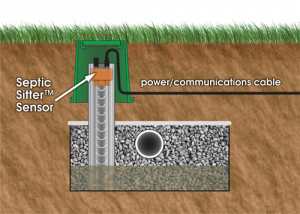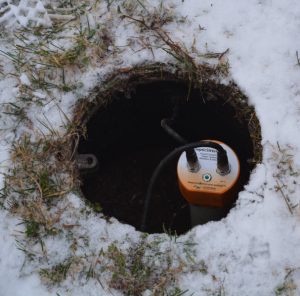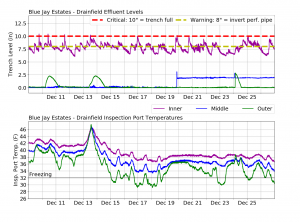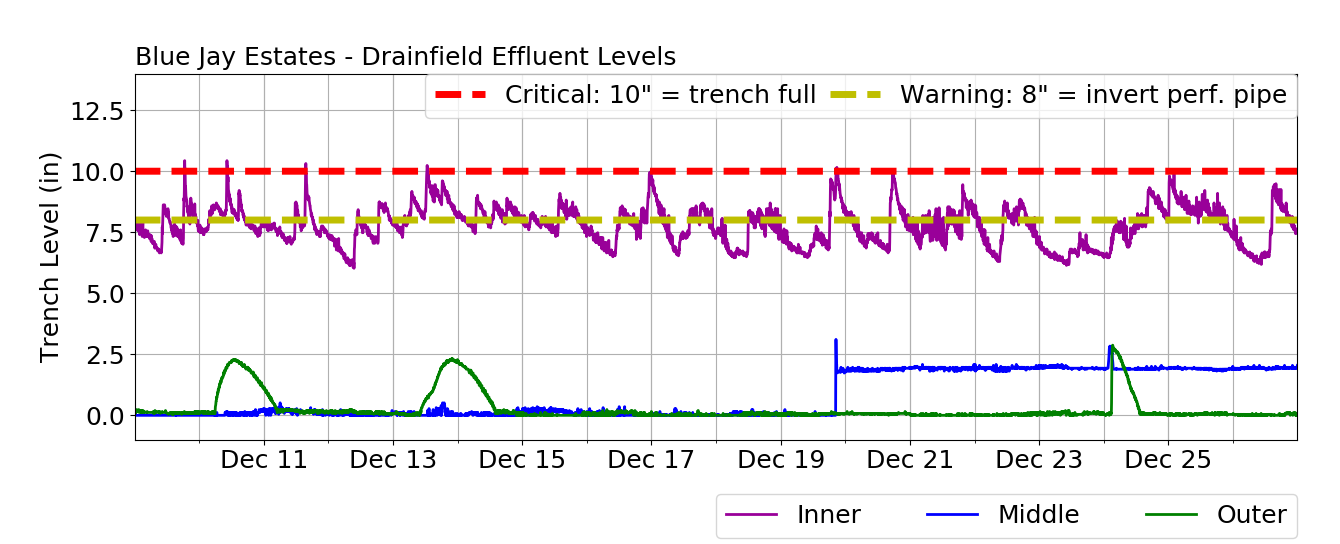Disaster – Winter Septic Backup!
Eight years ago, Mr. & Mrs. Jay of Winsloe, Prince Edward Island, Canada experienced a homeowner’s worst nightmare when they were the victims of a septic system backup into their home in the middle of winter. The drainfield was completely overloaded and saturated, so they had to resort to an expensive “pump and haul” regimen for several months until the ground dried up enough to allow the installation of a new drainfield.
The Site
The new drainfield is constructed in a raised-bed of silty sand fill. There are a total of six trenches, all gravity-fed in parallel from a common manifold pipe as shown in Figure 1. However, the Jay’s worried their new drainfield might catastrophically backup one day like their previous one.

Three trenches were retrofitted with inspection ports and SepticSitter™ sensors as shown in Figures 2 and 3.


Automatic Remote Monitoring
SepticSitter has been keeping watch over the Jay’s septic system for over two years. Figure 4 shows example data on drainfield ponding levels (inches) and inspection port temperatures (F) for the period Dec. 9/17 to Dec. 27/17. This data is taken directly from the SepticSitter web application.

Monitoring Insights
Some interesting observations can be made from an examination of the graphed data in Figure 4:
- Ponding levels (and likely effluent distribution) among the trenches is not very even. The Inner Trench near the center of the drainfield was consistently ponded the deepest, a minimum of 6 to 7 inches. Several times this trench filled completely to the top of the gravel. The Outer Trench rarely shows signs of ponding.
- On Dec. 19 when the Inner Trench filled completely, the Middle Trench suddenly started ponding 2 inches deep. This was likely a result of effluent spilling over from other trenches.
- There were moderate rainfall events on Dec. 10-11th, 13-14th and 24th. These rainfall events appear to have triggered slight, temporary ponding in the otherwise empty, Outer Trench.
- Infiltration rates can be estimated from an examination of the pattern of ponding levels on the graph for the inner trench. For trench ponding starting below 8 inches, infiltration rates ranged from 1.4 to 3.6 inches/day. When trench ponding started above 9 inches, infiltration rates were around 7 to 8 inches/day. The higher rates are likely due to upper portions of the trench sidewalls having less biomat buildup.
- Infiltration rates appeared to be getting lower in late December as subsurface temperatures dropped. This could be caused by the lower temperatures increasing the growth of slime forming bacteria which increases hydraulic resistance.
Owners Relieved
Once the sensors were retrofitted and detailed data was available, the homeowners were able to see that while the inner trench was full at times, the middle and outer trenches had excess capacity to receive effluent spill-over from overloaded trenches. The homeowners have been relieved to know their drainfield is currently able to handle the daily flows from their home, and if that ever starts to change, SepticSitter will let them know, long before a backup occurs!
Automatic 24/7 Monitoring & Alerts
It is not necessary for the homeowners or their onsite septic professional to have to check the web application unless they are curious about what has been going on underground. SepticSitter keeps watch so owners and professionals don’t have to. If ponding levels in the middle or outer trench rise above concerning levels, automatic alerts will provide warning through emailed notifications. Their septic professional will have time to propose a proactive plan to rejuvenate or upgrade the system before another catastrophic failure occurs.
Watch the video below to hear first hand about the pain of the Jay’s septic disaster, and how SepticSitter has given them peace of mind.
Key features and benefits of the SepticSitter system are:
- Prevents messy, costly failures – septic backup and breakouts of raw sewage on the lawn.
- Sensors are very easy to install and retrofit to new and existing septic systems.
- The same type of sensor can be retrofitted to all types of drainfields, tanks, treatment units, cesspools and distribution boxes.
- Just one line of cables connected end-to-end in daisy-chain fashion – no need to run individual wires to each sensor.
- Non-contact ultrasonic sensors won’t get “hung up” or fouled
- Uses existing internet service at home/business (a cellular internet option is also available)
- Warnings, alerts and notifications are fully customizable from the online web application
Your Turn
Septic owners – have you had the unfortunate experience of a septic backup? Was it a disaster?
Septic professionals – if this was your customer, how would you improve the distribution among the trenches and/or the infiltration rate?
Feel free to leave your comments below!

Comment